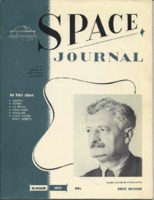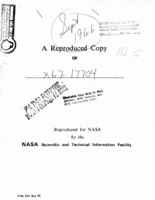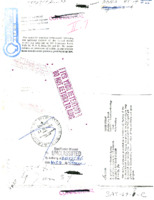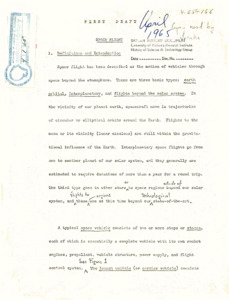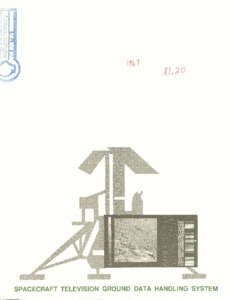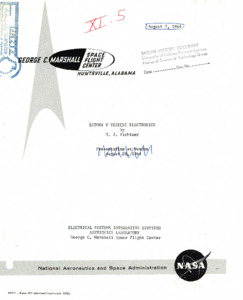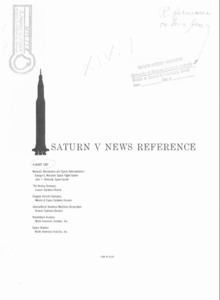
Browse Items (29 total)
Sort by:
-
Space Journal, vol. 1, no. 1., Summer 1957.
This issue of Space Journal includes articles written by Fred L. Whipple, Hermann Oberth, and Ernst Stuhlinger, as well as a foreword by Wernher von Braun. The issue also includes drawings for an observatory to be built at the top of Monte Sano Mountain in Huntsville, Alabama. Produced by the Rocket City Astronomical Association (now known as the Von Braun Astronomical Society), Space Journal was published in Huntsville from 1957 to 1959. This digitized copy was generously provided by Jeff Bennett at the Von Braun Astronomical Society (VBAS). -
"Application of the Saturn V Launch Vehicle to Unmanned Scientific Exploration of the Solar System."
According to the foreword, "This paper presents the results of a twelve-week mission and systems analysis of a combined Jupiter orbiter/solar probe mission utilizing the Saturn V launch vehicle." -
"Army Participation in the National Satellite and Space Program."
This paper, which was presented at a Semi-Annual Meeting of the American Rocket Society, traces the role of the United States Army in national space activities. Incorporated in the report are photographs illustrating the evolution of the satellite and space program. -
Oral History Interview With Joe Phillipauldy
Joe Phillipauldy is originally from Central, New Jersey. He did his undergraduate training at the University of Richmond in Virginia, and then he received his Master's degree at Villanove University. He then when on to get his graduate degree, and completed the program in 1984. His degree was in Experimental Psychology. In 1986, he accepted a job position with the Creatis Systems Tech Staff at Boeing Military Airplanes in Kansas. His first Human Engineering job was with Tech Staff. A project he spent a lot of time on was the Airforce I VC25 747 Presidential Replacement Program. With this, he did a workload analysis of the navigator crew station. After this work, Joe got involved with the Human Factors and Industrial Applications group. There, he ran task terms around the factory floor doing analyses and reporting on ergonomics issues on assembling vehicles. Later, he was able to work on the Space Station Vehicle Integration Contract in Huntsville, AL.Tags Oral History -
Oral History Interview With Robert McBrayer
After Robert McBrayer graduated college, he reported to the Johnson Space Center in March of 1963. He was there assigned to a section called "Biodynamics" and in that section, they worked on Human tolerances to impact sustaining acceleration and acoustics. Robert was assigned to the acoustics group, and his first job was to design and develop a machine to produce low-frequency pure tones to test humans. He also designed and developed a test chamber for testing humans, and he participated in doing the actual human test with the machines that he helped build. He helped document the results as well. After his venture in doing basic research, he went into an area called "crew's survival equipment design and development," and he was assigned pieces of equipment that were his to design, update, and help build. In 1966, Robert asked to be transferred from the Johnson Space Center to the Marshall Space Flight Center, and he then moved to Huntsville, AL. Robert was immediately put on the Orbital Workshop where they were writing task analysis, and procedures for crew station reviews. They did two of those, on in 1967 and the other in 1968. From the Orbital Workshop, he was responsible for all the crew interfaces on adapter, etc.Tags Oral History -
"Space flight : first draft."
Appears to be a rough dfraft with editorial comments and revision notes. Includes references to figures and tables.; Page 31 is missing. Pages 37 through 44 do not exist; there is a note about this on page 36. Page 67 also does not exist. -
"Spacecraft television ground data handling system."
A design report which displays and explains how the Spacecraft Television Ground Handling System functions, is designed and what it might be used for in the future. -
"Saturn V vehicle electronics."
This presentation is a review of the electrical and electronics systems of the Saturn V launch vehicle. Since airborne and ground electronics cannot be separated as a system, this presentation will touch upon both the airborne and ground checkout equipment. Certain airborne electronic items are singled out in order to elaborate upon the application of computers for checkout and launch. This review covered in a broad sense such airborne electronics as the control computer, the measuring telemetry and RF systems, the switch selector, the digital command receiver and the remote automatic calibration system. The ground support equipment electronics covered include such equipment as the data link, computer system and display systems. The importance of software in the Saturn V program is stressed by the application of a standard program language through the use of acceptance test or launch language (ATOLL). -
"Saturn V vehicle electronics."
This presentation is a review of the electrical and electronics systems of the Saturn V launch vehicle. Since airborne and ground electronics cannot be separated as a system, this presentation will touch upon both the airborne and ground checkout equipment. Certain airborne electronic items are singled out in order to elaborate upon the application of computers for checkout and launch. This review covered in a broad sense such airborne electronics as the control computer, the measuring telemetry and RF systems, the switch selector, the digital command receiver and the remote automatic calibration system. The ground support equipment electronics covered include such equipment as the data link, computer system and display systems. The importance of software in the Saturn V program is stressed by the application of a standard program language through the use of acceptance test or launch language (ATOLL). -
Saturn V news reference.
This book is designed to serve as an aid to newsmen in present and future coverage of the Saturn IB in its role in the Saturn/Apollo Program and as a general purpose large launch vehicle.
